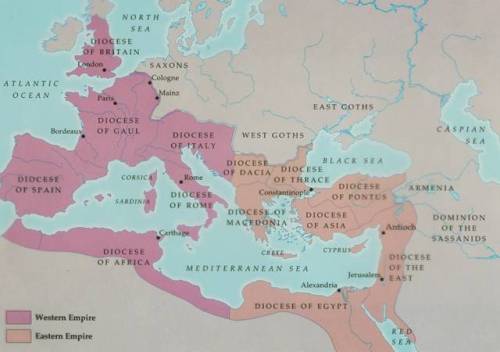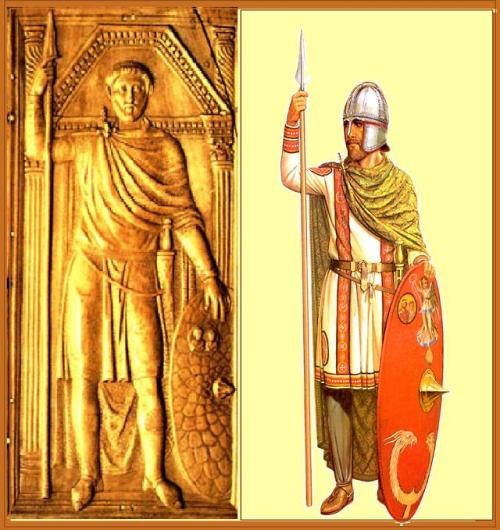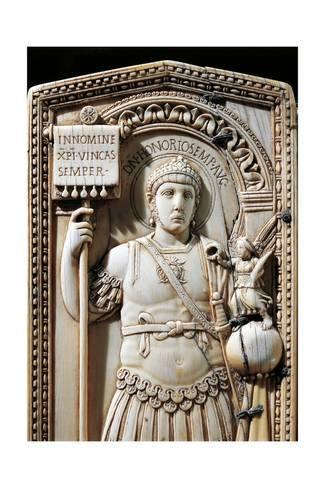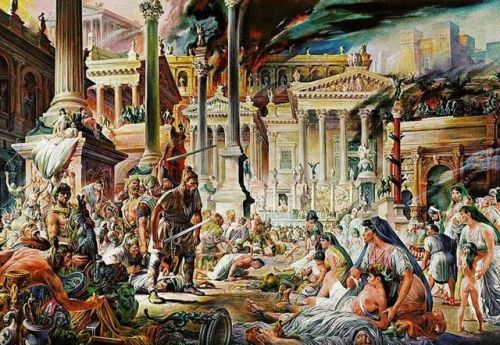peashooter85:The Evolution of the Roman Empire Part VII — Stilicho, Honorius, and the Destruction of
peashooter85:The Evolution of the Roman Empire Part VII — Stilicho, Honorius, and the Destruction of the Roman ArmyIn case you missed: Part I, II, III, IV, V, VIIn the last post I made the assertion that throughout and up to the late 4th century the Roman Army was very strong, and that despite the fact that the Western Roman Empire was on a sharp decline, the state scrapped up enough cash and resources to make sure that the army stayed that way. In the period between around 388 and 410 a series of events would occur that would bring about the downfall of the Western Roman Army as well as the Western Empire. Before I begin I want to give warning; the events I am writing about are extremely complex and very detailed. For brevity’s sake I am going to be leaving out a lot of details. Whole books have been written about this time period in Roman history. I myself could do an eight parts series on this time period alone. However I will do the best that I can to keep things short, simple, and cover most of the major points.At around 383 AD Rome was divided into two subdivisions. In the eastern half ruled Theodosius I, who was officially emperor of the entire empire, but de facto ruler of only the eastern empire. In the west the empire was co-ruled by two emperors, Gratian and Valentinian II. In that year a Roman general named Magnus Maximus rebelled against Rome, murdered Gratian, and declared himself emperor. In 388 Maximus marched on Italy and attempted to remove Valentianian II, making himself sole emperor of the west. However, Theodosius intervened and defeated Maximus’ army at the Battle of the Save. In 392 a Frankish/Roman general named Arbogast murdered Valentinian II and installed a Roman minister named Eugenius as emperor. Once against Theodosius intervened, and with an army of 20,000 Goths and 20,000 Eastern Roman soldiers defeated a similar sized Western Roman Army at the Battle of the Frigidius. While there are no records of the casualties resulting from these civil wars, one thing that is clear is that the casualties were described as being extremely heavy. Rome had suffered disastrous casualties before, such as the Battle of Cannae and the Battle of Arausio where in each near 80,000 Roman soldiers were massacred in a matter of hours. However, at this point in history the Roman Empire was suffering a sharp decline, a far cry from the empire of the Roman golden ages. Generations of incompetent leadership, rampant government corruption, and near constant civil war had taken it’s toll, leaving the empire with a depressed economy and a severe lack of resources. Suddenly, in the span of 4 years, the mighty Western Roman Army was reduced by a large fraction, and the empire had not the means to replace these losses.Theodosius I died in 395, being the last emperor to rule over a united Roman Empire. After his death, his two sons inherited the empire, Honorius in the West, and Arcadius in the East. When Honorius ascended to the throne he was but a young child, thus de facto rule of the empire fell upon his guardian, a Roman general of Vandal birth named Flavius Stilicho. Known now as one of the greatest generals in Roman history, Stilicho would come to power at a time when all hell was about to be unleashed upon the empire. Between the years 395 to 397 he put down a Visigoth revolt lead by King Alaric. Then in later 397 the Roman governor of North Africa, a general named Gildo, revolted against the empire and cut off the grain supply to Rome. This revolt was quashed just in time for the Picts to start up trouble along the northern border of Britain along Hadrian’s Wall. In 402 Alaric once again tried his hand at conquest by invading Italy and even laying siege to the Roman capital in Ravenna, once again Stilicho defeated him in battle. Alaric agreed to foederati status and promised military aid in the future. In 406 a massive barbarian invasion consisting of Alans, Sueves, and Vandals led by a Gothic king named Radagaisus invaded Italy, but once again were defeated by Stilicho.In order to build an army capable of dealing with so many crises, Stilicho was forced to recall legions from around the empire, especially near the border regions. In addition Stilicho filled the ranks of his army with barbarian recruits as well as foederati units. For example, in his campaign against Radagaisus, Stilicho’s army consisted of an odd mixture of Roman regulars as well as foederati Goths, Vandals, Huns, and Alans. As a result of Stilicho siphoning units away from the provinces,many parts of the empire were left undefended and the border along the Rhine and Danube was undermanned, allowing more barbarians to storm into Gaul (France). In response, the Governor of Britain, fed up with the empire’s inability to deal with the barbarians, would proclaim himself emperor, and moved all of his forces to Gaul. Stilicho would try to put down this revolt, but was unsuccessful. As a compromise, the British governor was made co-emperor, taking the name Constantine III. This was good enough for Stilicho, the last thing Rome needed was a civil war, and Constantine III could handle the barbarians in Gaul.After twelve years of shit hitting the fan, the empire still stood,all thanks to Stilicho. Despite seeing the empire through one crises after another, you would think that the Roman state would be kissing his feet. In reality, Stilicho had made a number of enemies, many of whom were ministers to the young emperor Honorius. They filled Honorius with rumors; that Stilicho planned to overthrow and replace Honorius, that the Vandal descended general had plans to sell out the empire to the barbarians, that Stilicho was a modern day Julius Caesar. As a result, Honorius ordered the death of Stilicho, and ordered a purging of pro-Stilicho elements in the government and army. On August 22nd, 408 Stilicho was captured and beheaded.With the death of Stilicho it was now up to Honorius and his regime to perform the juggling act that was managing the empire. Honorius was 24 years old. I know when I was 24 years old I was certainly not cut out to rule an empire in crises. Rome has had its share of incompetent, evil, and downright batshit crazy emperors, however by the reign of Honorius, Roman emperors were spoiled brats who spent most of their time cloistered in their palaces, drinking wine and playing backgammon, with no knowledge of how the real world worked. Honorius is particularly noted for being a dimwit. Fortunately for Honorius there was only one requirement he needed to fulfill and all would be well; DON’T PISS OFF THE BARBARIANS!!! By 408 a large percentage of the Roman Army was made up of barbarian recruits and was further reliant on foederati units. As I mentioned in the previous post, barbarians of the 5th century were not the raging hordes of popular imagination, but were well armed, well trained, and well organized professional armies manned by many veterans of the Roman Army. Also, unlike popular imagination, most barbarians were not out to conquer or destroy the empire, at least initially. Rather, most barbarians hoped to become a part of the empire, serving as full fledged Roman citizens.Stilicho was able to recruit the support of so many foederati by playing into these desires, promising that loyal tribes who completed an honorable term of service to the empire would be settled on a plot of land, given a stipend of grain until they became self sufficient, and eventually would be granted Roman citizenship. When Honorius came to power, he declared that all of Stilicho’s previous deals were off. As a result, most foederati deserted the Roman Army. Finally, one of Honorius’ ministers, a man named Olympius who was famous for orchestrating the death of Stilicho, declared that barbarians were no longer fit to live in Italy. Across Italy Imperial soldiers went from town to town, city to city, and rounded up thousands of barbarian men, women, elderly, and children, putting them to the sword. In response, Alaric and his Goths again revolted against the empire. Around 30,000 barbarian soldiers in the regular Roman Army would desert and join his cause along with thousands of barbarian refugees.The timing for this was bad for Honorius, as Constantine III had sent his army to invade Italy in an attempt to make himself sole emperor. Most loyal troops were away dealing with Constantine when Alaric and his army invaded Italy.In 408 Alaric laid siege to Rome, sending a message to the Roman Senate that it was time to renegotiate their deal. The Senate agreed, paying a sum of gold, silver, and clothing to the Goths as a sign of good faith as well as freeing 40,000 Goth slaves. However, Honorius intervened and declared that they would make no deals with the barbarians. Alaric laid siege to Rome again, and once again the Senate declared they were willing to make a deal. Again Honorius intervened saying “no deal!” Alaric laid siege to Rome a third time, this time sweetening the pot by offering to be settled along the Danube, where Gothic men would be enrolled in the Roman Army and would take responsibility for guarding the border. The Senate were practically jumping from their seats shouting, “yes! YES! WE WILL TAKE THAT DEAL!!!”. For some reason Honorius didn’t quite understand that when negotiating it helps to have some leverage on your side, especially when your demands are unconditional. If leverage could be measure on a scale from 1-10, Alaric would have a 10, Honorius would have a zero. Honorius once again declared that there would be no deal, sending small detachments of Roman soldiers, which Alaric’s army would easily ambush and destroy. In 410 AD Alaric and his Goths sacked Rome. The Goths looted the city and when satiated with enough plunder, moved north and settled in Gaul (France). Honorius was damned lucky they didn’t make a stop at Ravenna while on their way and claim his head as well. At the time, the only defenses available to Honorius were his palace guards.So what happened to the Roman Army between the years 388 and 410?Needless to say, the army was devastated by theses series of crises. Several clues can be inferred by a document called the “Notitia Dignitatum”, which was a registry of government offices throughout the empire. In addition, the book lists all military units, where they are stationed, and who commanded them. Published periodically, the last known surviving example from the Western Empire dates to 420 AD. After the sack of Rome, Constantius III (not to be confused with Constantine III) a general and co-emperor of Honorius would attempt to rebuild the Roman Army. In an analysis of the Notitia Dignatatum published in 390 and the one published in 420, the historian A. H. M Jones details the damage that had been done to the army and the measures Constantius III had attempted to rebuild it. According to Jones in his three volume book “The Later Roman Empire” ( available to read for free at archive.org), of the 181 comitatense legions that existed in 390, only 89 were still in existence by 420. This means that around 50% of Rome’s field army was destroyed (at the time a legion consisted of 1,000 men). Constantius III had managed to rebuild the army back to its 181 legions, however, the Roman Army was most likely only strong on paper. Of the 92 destroyed legions, only 21 replacement legions were created from new recruits. The rest were created by limitanei units that were promoted to comitatus status (Later Roman Empire, Vol 1, P. 196). Recall that limitanei units were not regular field army units. Their purpose was to guard the border, deal with small scale raids, and sound the alarm if a large invasion was on its way. They were light infantry reconnaissance units, guerrilla fighters, and part time militia, not front line combat heavy infantry. This poses the problem in that with less limitanei, there were now less men guarding the borders. In addition, most likely these men were not retrained and re-equipped to be comitatus units. Finally the Notitia Dignatatum does not give unit sizes, and it would not be unreasonable to assume that many of the units listed were undermanned and underequipped. BTW, the Notitia did have illustrations of the shield markings of different legions, which is pretty cool.Based on this information, most likely it can be assumed that the Roman Army was a shell of it’s formal glory. In the eighth and final installment of this series, what remains of the Roman Army will be whittled away to nothing, and finally Rome will cease to be.At least it will in the West. If anyone would like to pick up where I left off and do a series on the Byzantine Army, please please please let me know. -- source link
Tumblr Blog : peashooter85.tumblr.com



